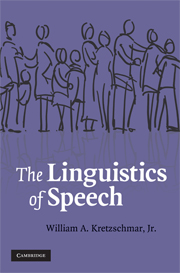Book contents
- Frontmatter
- Contents
- List of figures
- List of tables
- Acknowledgments
- The road not taken
- Introduction
- 1 The contemporary marketplace of ideas about language
- 2 Saussure
- 3 Evidence from linguistic survey research: basic description
- 4 Statistical evidence from linguistic survey research
- 5 Evidence from corpus linguistics
- 6 Speech as a complex system
- 7 Speech perception
- 8 Speech models and applications
- References
- Index
6 - Speech as a complex system
Published online by Cambridge University Press: 03 July 2009
- Frontmatter
- Contents
- List of figures
- List of tables
- Acknowledgments
- The road not taken
- Introduction
- 1 The contemporary marketplace of ideas about language
- 2 Saussure
- 3 Evidence from linguistic survey research: basic description
- 4 Statistical evidence from linguistic survey research
- 5 Evidence from corpus linguistics
- 6 Speech as a complex system
- 7 Speech perception
- 8 Speech models and applications
- References
- Index
Summary
The advances in procedures for effective statistical inference and valid sampling during the twentieth century discussed in the previous chapters depend on the “normal distribution,” also called the “Gaussian distribution.” The Empirical Rule permits us to decide what experimental results might be significant for us, provided that they come from normally distributed data. The Central Limit Theorem permits effective estimation from samples, since the results of repeated experiments on the same population yield normally distributed results. However, the bell curve became the twentieth-century model for what was “normal” in a wider sense for the social sciences (if not for the physical and natural sciences), so that many social situations, such as assessment of human intelligence (as by the educational psychologists against whom Labov wrote, described in Chapter 1), or assessment of socioeconomic status, or performance evaluation in educational settings, have tended automatically to be evaluated with respect to it. However, as we shall see, not all distributions are normal in the social sciences, as they are not in the physical and natural sciences. Distributions such as Zipf's Law for the relationship between rank and frequency for words in texts, or Pareto's Law for salaries in economics, do not conform to the bell curve. Benoit Mandelbrot has written, regarding the acceptance of these “other” distributions, that (1977: 273):
Even the less bold among physicists would find it hard to imagine the fierceness of the opposition that the very same procedure and outcome experienced in the social sciences. The procedure was unforgivable because its outcome flew in the face of the Gaussian dogma, which has long ruled uncontested among professional statisticians and hence among social scientists.
- Type
- Chapter
- Information
- The Linguistics of Speech , pp. 174 - 217Publisher: Cambridge University PressPrint publication year: 2009

